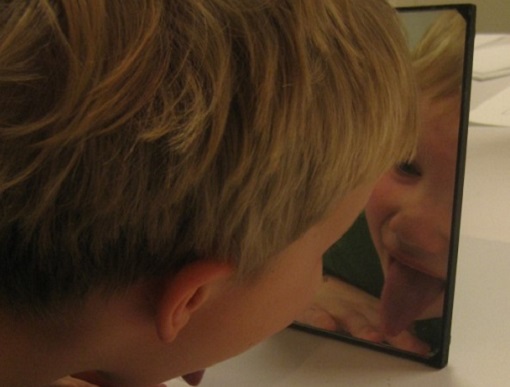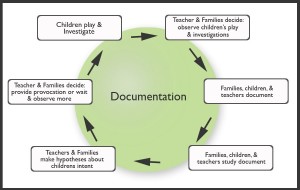
Reflective Practice to Support Playful Inquiry
by Sarah Felstiner, Curriculum Director, Hilltop Children’s Center
Children are naturally playful, and naturally curious. As educators, we want to nurture and encourage this capacity for playful inquiry, and even engage in playful inquiry ourselves. But just wanting to have a program rich in exploration and deep investigation doesn’t seem to do the trick!
Earlier this month, I attended a fantastic Symposium at the breathtakingly-awesome Opal School in Portland, Oregon. The Opal educators led participants in three full days of thinking and touring and conversation, all focused on how we can support a Pedagogy of Play. As part of that conversation, I offered a session about how we – educators and program leaders – can build structures that encourage a reflective attitude, and thereby support our intentions for playful inquiry.
One of my inspirations for this topic is the work of my colleagues at Harvest Resources Associates, who are tremendous champions of reflective practice and responsive pedagogy. In their book Reflecting in Communities of Practice, Deb Curtis, Debbie Lebo, Wendy Cividanes and Margie Carter suggest that
“For reflective teachers, work is an ongoing process of closely observing and studying the significance of unfolding activities…to better understand and delight in what happens in the classroom. Reflection allows teachers to make effective, meaningful decisions about how to respond to and plan for children.”
They go on to say that reflective educators:
- Look for details
- Ask themselves questions
- Consider children’s perspectives
- Examine the environment
- Are eager to gain more perspectives
- Are fully engaged in their work
So what is it that actually helps educators be reflective in those ways? Are there structures that program leaders can put in place to support educators with these intentions? As we continue to explore this question at Hilltop, we’ve discovered, and built into our daily lives at the school, several structures which we think help empower our educators to work reflectively with children, families, and each other.
Responsive Planning
At Hilltop, we view curriculum as everything that happens during our time together with the children. Therefore, our curriculum is not set in advance, but rather develops from the interests of the children in the class. Our planning cycle usually includes these components:
- adding engaging invitations to the environment
- observing and documenting children’s play
- talking with the teaching team about possible next steps
- exploring ways to engage families
Pedagogical Documentation
We engage in the active process of observing and studying children’s work, and we also invest time in turning some of these stories into written products that describe classroom life. We use two loosely structured formats for these written stories:
- “4 elements” compositions to recount group activities, so called because they always contain four components: Tell the Story, Reflect on the Story, Begin a Dialogue with Families, Describe Next Steps and Future Plans
- “Learning Stories” to celebrate moments of discovery for individual children, which are based on the models from New Zealand and from Seattle’s own Tom Drummond
In-Depth Investigations
Child-led investigations may last an hour, a day, a week, or may develop into an In-Depth Investigation that spans several months. In this kind of responsive curriculum:
- participants act as researchers, working together to uncover shared understanding of the topic
- topics evolve from children’s interests and questions, rather than from pre-packaged curricula
- the study is collaborative, with children, educators and parents all helping to refine the research
- children have a high investment in the study, though much of their time is still spent in other play
Team Teaching and Team Meetings
- Hilltop hires teams of three master educators to work in each of our classrooms, rather than identifying “lead” and “assistant” teachers.
- Classroom educators collaborate and share responsibility for planning curriculum, communicating with families, and documenting learning.
- Each team meets once a week for an hour, to examine and discuss “raw data” from the classroom, and make plans for the weeks to come.
- At our team meetings, we often use reflective protocols, such as The Thinking Lens, to help structure and deepen our conversations.
Planning Time
- Each educator has several hours each week of protected time outside the classroom, for planning activities, communicating, and documenting.
- Educators use this time to send e-mails, gather materials, meet with families or each other, and complete at least one piece of written documentation.
Fall Family Gatherings and Fall Conferences
- Each classroom has a gathering of families in the fall, to begin working together in studying children’s play and learning.
- Educators have individual meetings with each of their “primary contact” families in the fall, to build relationships and identify hopes for the year.
Cooperative Assessment and Collaborative Conferences
- Educators prepare for our “Mid-Year Conferences” by completing a developmental worksheet about each child, and families complete the same worksheet about their own child.
- When children are engaged in an In-Depth Investigation, we host gatherings for their families to explore the work and share ideas and feedback with educators.
Communities of Practice
- Hilltop educators participate in small-group professional learning communities, with other Hilltop faculty, to help them hone their skills as leaders and advocates.
- Examples of current Communities of Practice include: Blog Publication, Presenting, and Coaching/Consulting.
- Newer Hilltop faculty continue to meet as a cohort throughout their first two years of employment.

Clearly, there’s no question that I’m a structure girl. My sock drawer is alphabetized, my desk is disturbingly neat, my kitchen pantry is so organized it’s basically a cry for help… But I’ve found that sometimes it takes an organized, disciplined structure to create freedom for reflective practice, and playful inquiry. I think this quote, attributed to Henry David Thoreau, helps explain the virtue and value of supportive structures:
“If you have built castles in the air, your work need not be lost. That is where they should be. Now put the foundations under them.”
[author] [author_image timthumb=’on’]https://hilltopcc.com/wp-content/uploads/2016/01/Sarah-Felstiner-photo-square.jpg[/author_image] [author_info]Sarah Felstiner is the Curriculum Director at Hilltop Children’s Center, where she has worked since 1995.[/author_info] [/author]